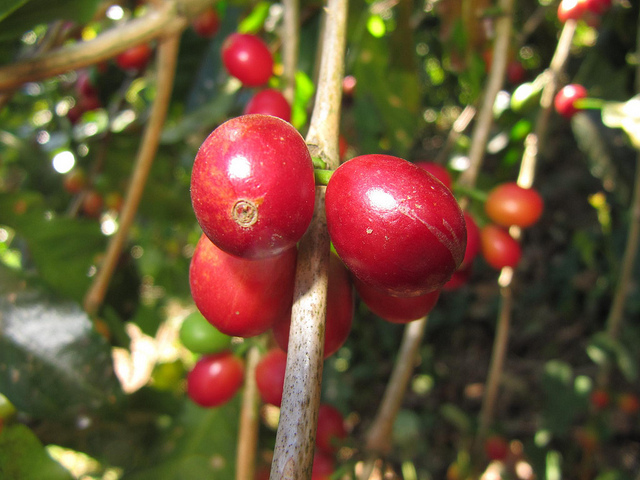The characteristics and Origin of the passionate Brazilian Santos Coffee
Santos Coffee (Santos Coffee)
Mainly produced in Sao Paulo, Brazil. This kind of coffee acid, sweet and bitter is neutral, moderate concentration, with moderate sour taste, elegant and special taste, is the best blending beans, known as the strong coffee, but the taste is also good. Brazil is located in South America, about 15 degrees south latitude. Brazilian coffee culture began in 1727 and sprang up in the north of Brazil when a Mr. FrancescodeMelopalhata smuggled coffee seeds from France to Brazil. At that time, this was strongly opposed by the French who monopolize the coffee business today. Those seeds are the ancestors of more than 300 million Brazilian coffee trees today. In early Brazilian history, coffee started very slowly.
After Mr Palhta returned to Brazil, coffee culture began in the state of Bela, which is at the mouth of the Amazon. Coffee has a wide planting area and is the largest coffee exporter in the world.
But the famous "Santos" takes his name from the port where coffee is shipped, coffee in the valley around the capital, S ã o Paulo.
Characteristics.
Santos coffee is mainly produced in Sao Paulo, Brazil. This kind of coffee acid, sweet and bitter is neutral, moderate concentration, with moderate sour taste, elegant and special taste, is the best blending beans, known as the backbone of coffee, single drink flavor is also good. Santos Coffee is pure and smooth, with high acidity and moderate silk, with a slight nutty flavor.
Origin
The name "Santos" comes from the port where coffee is shipped, and coffee in the valley around the capital, Sao Paulo, is the most typical coffee in Brazil. Santos is a neutral bean, the best flavor is known as the crown of coffee, if the preparation of other coffee has a unique flavor, the most suitable for people with aristocratic flavor, sense of humor and strong interpersonal relationships. The high-quality Brazilian Bourbon Santos coffee is comparable to Blue Mountain Coffee. If Blue Mountain is the king of coffee, then Brazilian Bourbon Santos Coffee is a hermit in the coffee kingdom. Like all Brazilian coffees, they are best served when they are fresh and tender, because the older they are, the more acidic they are. Although Brazil is known as the "kingdom of coffee", the hometown of coffee is not in Brazil, but in the Ethiopian province of Cafa in Africa. The name "Coffee" evolved from the place name of "Kafa". Coffee was introduced into Brazil after the 18th century. In 1727, Brazil had a border dispute with its northern neighbor French Guiana. In order to prevent the situation from spreading, the Brazilian Governor sent a delegation of military officer Francisco de Moro Barreta to French Guiana for negotiations in an attempt to resolve the dispute between the two countries by peaceful means. Unexpectedly, his border negotiations failed, but unexpectedly became the "father of coffee" of Brazil.
French Guiana introduced coffee in 1722, first planted it in the backyard of the Government House, and then planted it on a small scale on a nearby farm. The Governor regarded caffeine as a "national treasure" for fear of being taken away by neighboring countries, especially Brazil, which was militarily and economically dominant at that time, so there were soldiers with guns patrolling around the coffee garden day and night.
After Moro Barretta arrived in Guyana, the coffee garden was heavily guarded and heavily guarded to keep Moro Barreta and his party from getting half a step closer. However, the handsome young officer won the favor of the governor's wife, not only invited Moro Barretta to taste coffee, but also personally accompanied him to visit the coffee garden, and presented a handful of ripe coffee beans and five coffee seedlings to Moro Barretta. After getting the seeds, Moro Barreta immediately left Guyana to escort the "national treasures" to Brazil. Since then, coffee has settled in Brazil. Those seeds are the ancestors of more than 3.9 billion Brazilian coffee trees today. In the early history of Brazil, coffee started very slowly. When Mr Molobaleta returned to Brazil, coffee culture began in the state of Para, at the mouth of the Amazon. About 1773, coffee was introduced from the north to Brazil's traditional agricultural areas on the southeast coast: Rio de Janeiro and Sao Paulo. As the climate here is very suitable for growing coffee, coupled with fertile land, cheap labor and other factors, coffee production in Brazil has developed rapidly. At the beginning of the 19th century, coffee was grown all over the country, followed by a "coffee boom" that lasted nearly a century.
Important Notice :
前街咖啡 FrontStreet Coffee has moved to new addredd:
FrontStreet Coffee Address: 315,Donghua East Road,GuangZhou
Tel:020 38364473
- Prev

Exploring the secret of the world's most expensive coffee in Bali Coffee the world's most expensive coffee cat shit
If at this moment, there is a cup of coffee made from a special cat poop, placed in front of you, do you have the courage to try? As one of the most expensive coffee in the world, kopi luwak, a famous coffee from Indonesia, is made from the excrement of civets that are unique to the region. In Bali, Indonesia, my friends and I had the honor to visit.
- Next

Introduction to UCC Coffee Coffee about UCC Coffee UCC quality Japanese Coffee
UCC Coffee UCC Coffee is a world famous brand coffee produced and sold by Japan UCC Shangshima Coffee Co., Ltd., which is based on coffee beans carefully cultivated and planted. Brand introduction: brand name: UCC belongs to the country: Japan has studied coffee painstakingly for more than 80 years. In order to offer you a cup of delicious coffee anytime and anywhere
Related
- What brand of black coffee is the most authentic and delicious? what are the characteristics of the flavor of the authentic Rose Summer Black Coffee?
- Introduction to the principle and characteristics of the correct use of mocha pot A detailed course of mocha pot brewing coffee is described in five steps.
- Which is better, decaf or regular coffee? how is decaf made?
- How much is a bag of four cat coffee?
- How about four Cat Coffee or Nestle Coffee? why is it a cheap scam?
- Which is better, Yunnan four Cats Coffee or Nestle Coffee? How about cat coffee? is it a fake scam? why is it so cheap?
- How about Cat Coffee? what grade is a hoax? which instant coffee tastes better, four Cat Coffee, Nestle Coffee or G7 coffee?
- Process flow chart of coffee making-Starbucks coffee making process what coffee tastes good at Starbucks
- The top ten best coffee beans in the world Rose summer coffee or Tanzanian coffee tastes good
- Yunnan four cat coffee is good to drink?_four cat coffee is a big brand? four cat blue mountain coffee is fake?

